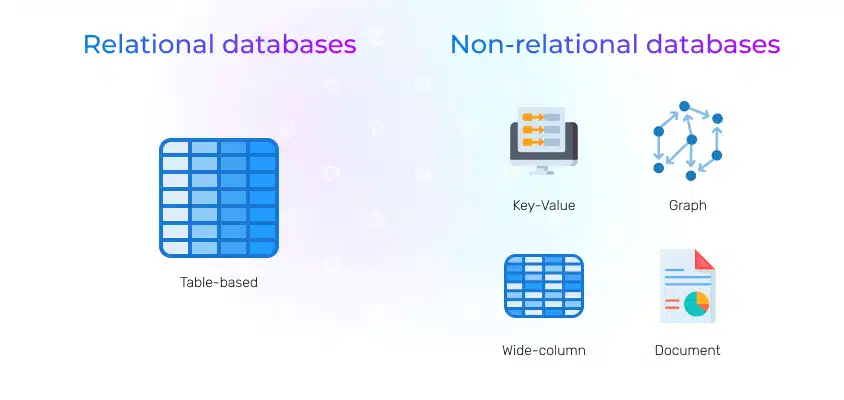Types of Databases, Pros & Cons, and Real-World Examples
Dee Radh
May 30, 2024

Summary
This blog offers a comprehensive overview of major database models—including relational, NoSQL, in‑memory, graph, and hybrid types—highlighting their strengths, weaknesses, and real-world use cases to guide decision-makers in selecting the right database for their needs.
- Relational (SQL): Ideal for structured, ACID-compliant workloads—great for transactions and complex queries—but can struggle with horizontal scaling and rigid schema.
- NoSQL (Document, Key‑Value, Columnar): Offers high flexibility and horizontal scalability for large, unstructured data sets; may sacrifice consistency, require complex modeling, and incur training/development costs.
- In‑Memory & Graph/Hybid Models: In‑memory databases deliver ultra-low latency; graph databases simplify relationship-heavy queries. Hybrid systems (like Actian’s) combine OLTP and OLAP strengths for real-world analytic performance.
Databases are the unsung heroes behind nearly every digital interaction, powering applications, enabling insights, and driving business decisions. They provide a structured and efficient way to store vast amounts of data. Unlike traditional file storage systems, databases allow for the organization of data into tables, rows, and columns, making it easy to retrieve and manage information. This structured approach, coupled with data governance best practices, ensures data integrity, reduces redundancy, and enhances the ability to perform complex queries. Whether it’s handling customer information, financial transactions, inventory levels, or user preferences, databases underpin the functionality and performance of applications across industries.
Types of Information Stored in Databases
Telecommunications: Verizon
Verizon uses databases to manage its vast network infrastructure, monitor service performance, and analyze customer data. This enables the company to optimize network operations, quickly resolve service issues, and offer personalized customer support. By leveraging database technology, Verizon can maintain a high level of service quality and customer satisfaction.
E-commerce: Amazon
Amazon relies heavily on databases to manage its vast inventory, process millions of transactions, and personalize customer experiences. The company’s sophisticated database systems enable it to recommend products, optimize delivery routes, and manage inventory levels in real-time, ensuring a seamless shopping experience for customers.
Finance: JPMorgan Chase
JPMorgan Chase uses databases to analyze financial markets, assess risk, and manage customer accounts. By leveraging advanced database technologies, the bank can perform complex financial analyses, detect fraudulent activities, and ensure regulatory compliance, maintaining its position as a leader in the financial industry.
Healthcare: Mayo Clinic
Mayo Clinic utilizes databases to store and analyze patient records, research data, and treatment outcomes. This data-driven approach allows the clinic to provide personalized care, conduct cutting-edge research, and improve patient outcomes. By integrating data from various sources, Mayo Clinic can deliver high-quality healthcare services and advance medical knowledge.
Types of Databases
The choice between relational and non-relational databases depends on the specific requirements of your application. Relational databases are ideal for scenarios requiring strong data integrity, complex queries, and structured data. In contrast, non-relational databases excel in scalability, flexibility, and handling diverse data types, making them suitable for big data, real-time analytics, and content management applications.

Image ⓒ Existek
1. Relational Databases
Strengths
Structured Data: Ideal for storing structured data with predefined schemas
ACID Compliance: Ensures transactions are atomic, consistent, isolated, and durable (ACID)
SQL Support: Widely used and supported SQL for querying and managing data
Limitations
Scalability: Can struggle with horizontal scaling
Flexibility: Less suited for unstructured or semi-structured data
Common Use Cases
Transactional Systems: Banking, e-commerce, and order management
Enterprise Applications: Customer Relationship Management (CRM) and Enterprise Resource Planning (ERP) systems
Real-World Examples of Relational Databases
- MySQL: Widely used in web applications like WordPress.
- PostgreSQL: Used by organizations like Instagram for complex queries and data integrity.
- Oracle Database: Powers large-scale enterprise applications in finance and government sectors.
- Actian Ingres: Widely used by enterprises and public sector like the Republic of Ireland.
2. NoSQL Databases
Strengths
Scalability: Designed for horizontal scaling
Flexibility: Ideal for handling large volumes of unstructured and semi-structured data
Performance: Optimized for high-speed read/write operations
Limitations
Consistency: Some NoSQL databases sacrifice consistency for availability and partition tolerance (CAP theorem)
Complexity: Can require more complex data modeling and application logic
Common Use Cases
Big Data Applications: Real-time analytics, IoT data storage
Content Management: Storing and serving large volumes of user-generated content
Real-World Examples of NoSQL Databases
- MongoDB: Used by companies like eBay for its flexibility and scalability.
- Cassandra: Employed by Netflix for handling massive amounts of streaming data.
- Redis: Utilized by X (formerly Twitter) for real-time analytics and caching.
- Actian Zen: Embedded database built for IoT and the intelligent edge. Used by 13,000+ companies.
- HCL Informix: Small footprint and self-managing. Widely used in financial services, logistics, and retail.
- Actian NoSQL: Object-oriented database used by the European Space Agency (ESA).
3. In-Memory Databases
Strengths
Speed: Extremely fast read/write operations due to in-memory storage
Low Latency: Ideal for applications requiring rapid data access
Limitations
Cost: High memory costs compared to disk storage
Durability: Data can be lost if not backed up properly
Common Use Cases
Real-Time Analytics: Financial trading platforms, fraud detection systems
Caching: Accelerating web applications by storing frequently accessed data
Real-World Examples of In-Memory Databases
- Redis: Used by GitHub to manage session storage and caching.
- SAP HANA: Powers real-time business applications and analytics.
- Actian Vector: One of the world’s fastest columnar databases for OLAP workload.
Combinations of two or more database models are often developed to address specific use cases or requirements that cannot be fully met by a single type alone. Actian Vector blends OLAP principles, relational database functionality, and in-memory processing, enabling accelerated query performance for real-time analysis of large datasets. The resulting capability showcases the technical versatility of modern database platforms.
4. Graph Databases
Strengths
Relationships: Optimized for storing and querying relationships between entities
Flexibility: Handles complex data structures and connections
Limitations
Complexity: Requires understanding of graph theory and specialized query languages
Scalability: Can be challenging to scale horizontally
Common Use Cases
Social Networks: Managing user connections and interactions
Recommendation Engines: Suggesting products or content based on user behavior
Real-World Examples of Graph Databases
- Neo4j: Used by LinkedIn to manage and analyze connections and recommendations.
- Amazon Neptune: Supports Amazon’s personalized recommendation systems.
Factors to Consider in Database Selection
Selecting the right database involves evaluating multiple factors to ensure it meets the specific needs of your applications and organization. As organizations continue to navigate the digital landscape, investing in the right database technology will be crucial for sustaining growth and achieving long-term success. Here are some considerations:
1. Data Structure and Type
Structured vs. Unstructured: Choose relational databases for structured data and NoSQL for unstructured or semi-structured data.
Complex Relationships: Opt for graph databases if your application heavily relies on relationships between data points.
2. Scalability Requirements
Vertical vs. Horizontal Scaling: Consider NoSQL databases for applications needing horizontal scalability.
Future Growth: For growing data needs, cloud-based databases offer scalable solutions.
3. Performance Needs
Latency: In-memory databases are ideal for applications requiring high-speed transactions, real-time data access, and low-latency access.
Throughput: High-throughput applications may benefit from NoSQL databases.
4. Consistency and Transaction Needs
ACID Compliance: If your application requires strict transaction guarantees, a relational database might be the best choice.
Eventual Consistency: NoSQL databases often provide eventual consistency, suitable for applications where immediate consistency is not critical.
5. Cost Considerations
Budget: Factor in both initial setup costs and ongoing licensing, maintenance, and support.
Resource Requirements: Consider the hardware and storage costs associated with different database types.
6. Ecosystem and Support
Community and Vendor Support: Evaluate the availability of support, documentation, and community resources.
Integration: Ensure that the database can integrate seamlessly with your existing systems and applications.
Databases are foundational to modern digital infrastructure. By leveraging the right database for the right use case, organizations can meet their specific needs and leverage data as a strategic asset. In the end, the goal is not just to store data but to harness its full potential to gain a competitive edge.
Subscribe to the Actian Blog
Subscribe to Actian’s blog to get data insights delivered right to you.
- Stay in the know – Get the latest in data analytics pushed directly to your inbox.
- Never miss a post – You’ll receive automatic email updates to let you know when new posts are live.
- It’s all up to you – Change your delivery preferences to suit your needs.


